What is a Squash Vine Borer?
The squash vine borer is the larva stage of a 1/2″ long diurnal sesiid moth. This beautiful moth, often mistaken for a wasp, has a bright orange abdomen with black spots and two sets of wings, one metallic green, the other transparent. Although it is striking in its appearance, it is better known for the destruction its larvae can do to cucurbits. Yellow squash, zucchini, patty pan (scallop) squash, and pumpkins, in particular, are targets of the vine borer, but cucumbers and melons can also fall prey to this insect. Although the moths usually do not bother butternut squash and acorn squash, I have found squash vine borer eggs on these plants in my container garden.
The moth typically lays one or more copper-colored eggs at the base of the host plant or along stems or sometimes on a leaf. Although they are similar in appearance to squash bug eggs, they are not laid in a cluster.
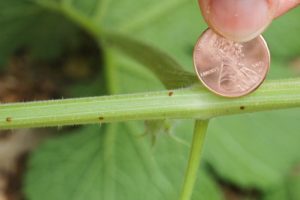
One to two weeks later, the egg or eggs will hatch, and a cream-colored larva with a brown head will burrow or bore into the stems to feed, hence the name squash vine borer. In a period of two to four weeks, the larva will grow to about one inch in length, which is big enough to block the flow of water and nutrients to the rest of the plant. The result is that your healthy squash plant will wilt, seemingly overnight. Unfortunately, most infected plants will die unless intervention occurs before the larva can develop.
Once the larva has fully developed inside the stem, it will emerge and burrow into the soil to pupate. It will remain there until the following June or early July when it surfaces as a moth and repeats the cycle. Some who live in the south, however, report vine borer moths can lay eggs in November and December, as well. If you live in a warmer climate, you may want to remain vigilant until your harvest is complete.
How to Determine If Your Plant Has A Vine Borer?
One sure way to know whether or not your cucurbit has a vine borer is the presence of one or more entry holes located on the base of the plant, near the soil. You’ll have to inspect your plants carefully because the holes are very small in the beginning. In addition, you’ll see what is called frass, which is larva excrement that looks like sawdust. Your plant will begin to wilt soon after the larva has burrowed into the stem.
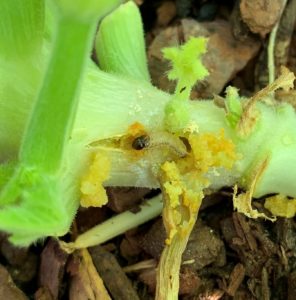
How to Treat Squash Vine Borers Organically
Although the end result of a vine borer infestation means the demise of the host plant, if caught early, the plant may be recover. Here are some steps you can take to fight the borers.
1. Perform Plant Surgery
Using a flashlight at night, illuminate the stem where you found the frass. You should be able to see the larva because the stem is hollow. Using a knife, cut a slit lengthwise in the stem. Do not cut across the stem as this will sever it from the plant. Carefully, open the slit using the knife or a pair of tweezers and extract the larva or larvae, as there can be more than one, and dispose of it.
Next, gently wash out the cut with clean water, removing any frass. If the incision is significant, some suggest drying it off and wrapping it with duct tape to help close the wound. Otherwise, cover the cut with moist compost or good soil, and hopefully, the plant will take root.
Alternatively, some suggest eliminating the need for surgery by using a toothpick to pierce through the stem and the larva, which should kill it. Leave the toothpick in the stem and cover it and the wound with moist compost or good soil.
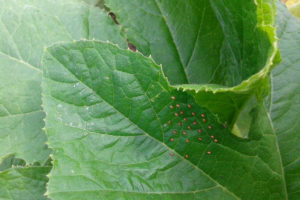
This article contains affiliate links. If you make a purchase using one of these links I will receive a very small commission at no additional cost to you, and it will help me maintain this website. Rest assured, I only recommend products I actually like!
2. Apply DE, Neem Oil or Insecticidal Soap
Try applying diatomaceous earth (DE) around the base of your plant. (Be sure to read the directions.) You can also try spraying neem oil (this is the brand I use). Not only do insects dislike the way it smells, it will disrupt the insect’s hormones, preventing it from developing the next stage in its life cycle. Be sure to reapply both DE and neem oil after it rains.
Another option is to spray insecticidal soap on the base of the plant once a week. If the soap comes into contact with an egg, it will suffocate it, otherwise, it will not work. You can find recipes for an effective insecticidal soap and neem oil spray in this article.
3. Inject the infected stem with Bt (Bacillus thuringiensis).
Bt has been classified by the Organic Materials Review Institute (OMRI) about as a natural pesticide that is safe for humans. It will only harm pests that consume it, thus, pollinators are not effected. In order for Bt to be effective against vine borers, however, it must be injected into the infected stem using a syringe. Applying it to the outer surface of the stem will not kill the borer that is sheltered on the inside of the stem. Here’s a link with a step by step guide if you’d like to learn more.
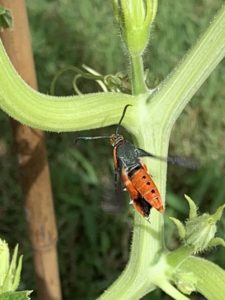
How to Prevent Squash Vine Borers
Since these insects can be so destructive, especially to small gardens, it’s best to prevent them. Here are some steps you can take:
1. Inspect your garden daily, if not more often, especially from mid-June thru the first few weeks of July when the moths are laying their eggs. You are more likely to see the moths early in the morning. Their bright coloring helps makes them more noticeable. But even if you don’t see the moth, be sure to check the plant’s base, as well as the leaves and stems for borer eggs.
2. Set out a decoy for the moths. Since they are pollinators, they are attracted to the bright yellow squash flowers. Therefore, place a yellow cup or bowl filled with soapy water in with the squash plants. Once the moths fall into the water, they should be unable to get out.
3. Plant your squash early so that you can harvest them before the moths come in mid-summer. This may not be feasible in cooler climates.
4. Forego the spring planting and wait to plant your squash until mid-July, after the threat of the vine borers has passed.
5. Cover the main stem of the plant so that the moths don’t have access to it and thus, can’t lay their eggs. You can use mulch, but you’ll need to add more as the stem grows. Or, some report success by covering the stems with aluminum foil or nylon stockings.
6. Use row covers to protect the plants so that moths don’t get access to them. You’ll need to remove the covers when the flowers bloom so they can be pollinated by bees. Alternatively, you can hand pollinate the flowers.
Installing row covers could be a problem, however, if there are pupae in the soil. Instead of blocking the moths out, they will be trapped under the covers with the plants. Be sure there are no eggs or signs of active larva present before installing a row cover.
7. Parasitic wasps are the borer’s natural enemy. Consider adding them to your garden. Be sure to do so before the moths lay their eggs.
8. Consider growing winter squash, like acorn and butternut squash, instead of summer squash, as the vine borer is typically not as interested in them. A word of caution, however, I live in a southern climate and have had problems with the squash vine borer even on winter squash.
Squash vine borers can cause gardeners much frustration and loss of plants. But these treatment options and methods of prevention should help equip you to diminish, if not eliminate, this garden menace.
Note: If you found this article to be helpful, please share it with someone via email or social media. Thank you!
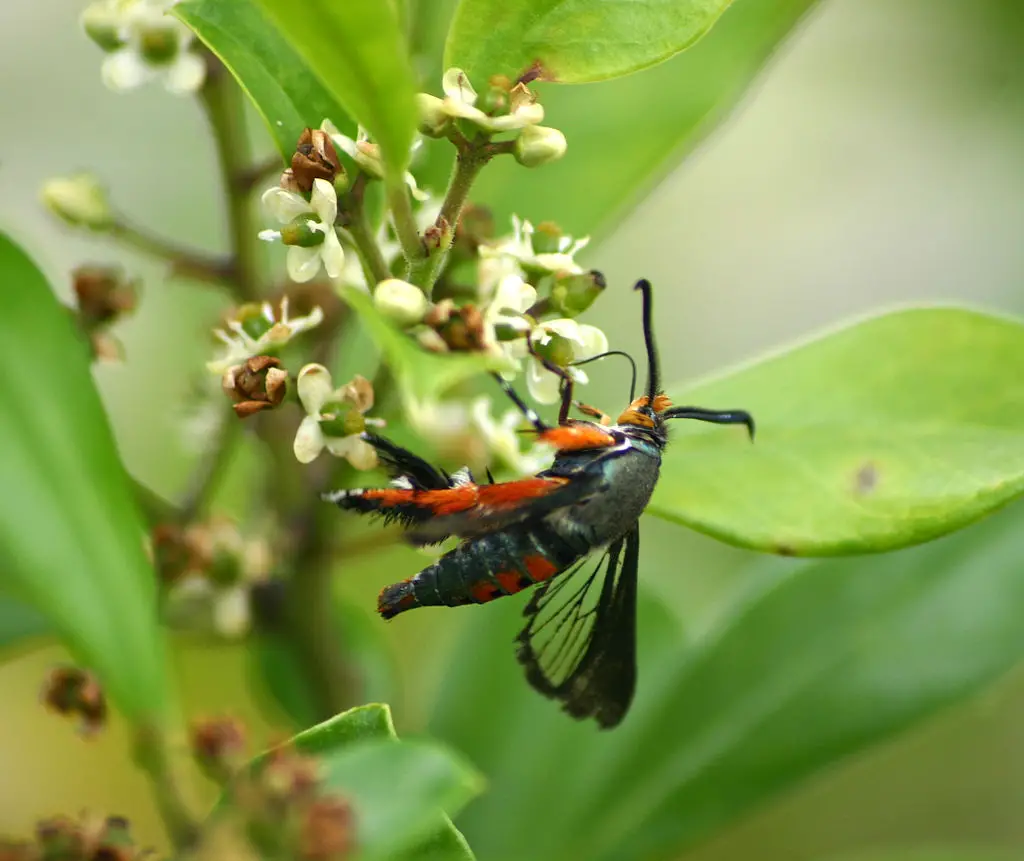
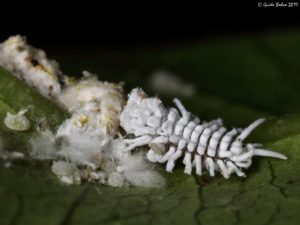
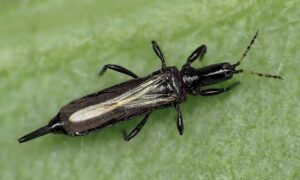
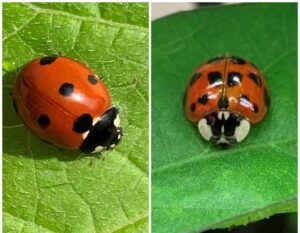
This is fantastic information! I think it’s cucurbita pepo that the svb likes which includes acorn squash. Cucurbita Moschata is usually safer, or so I’ve read. I’ve had a big battle
with svb this summer and another round last week. But I planted the squash late. Will plant earlier next year!
Thanks Kathy for stopping by the blog and commenting. I appreciate your kind words. I planted zucchini early this year and didn’t have a problem. But today I caught a SVB red-handed on my delicata and butternut squash plants. I posted some pics of it on Instagram today. SVB really keeps us on our toes!
Thanks again for your encouragement.
Blessings 🙂